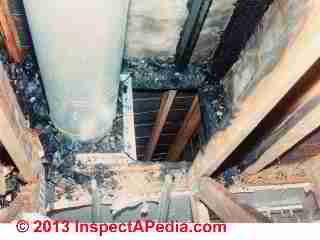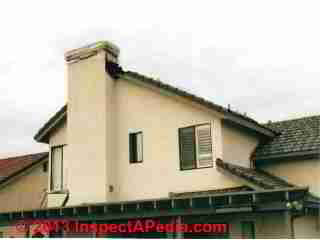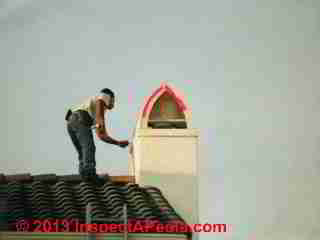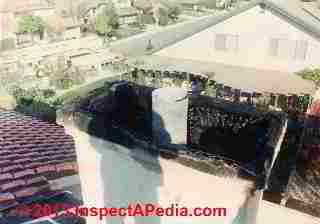 Chimney Chase & Shroud Fire Report
Chimney Chase & Shroud Fire Report
Chimney fire traced to unsafe top shroud & counterfeit UL label
- POST a QUESTION or COMMENT about wood-frame chimney chase fires, causation, prevention, damage
Chimney chase & top shroud fire case report:
this article provides photos and description of a Moorpark CA chimney fire whose origin was an unsafe chimney top shroud. Remarkably the shroud bore a counterfeit UL listing label.
InspectAPedia tolerates no conflicts of interest. We have no relationship with advertisers, products, or services discussed at this website.
- Daniel Friedman, Publisher/Editor/Author - See WHO ARE WE?
Chimney Fire Case Report: unsafe to shroud, counterfeit UL product label
Steve Werner, Chimney King LLC.
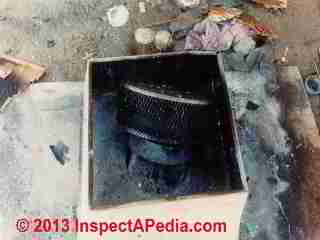
Watch out: according to both Steve Werner and to Dale Feb, some fireplace top shrouds or surrounds installed on some chimney chase tops may unsafe due to heat trapping at the chimney top. Such shrouds usually violate local and national building codes as well.
The house fire illustrated by these photographs (provided by Mr. Werner) occurred in Moorpark CA [date, fire district, details needed] and was attributed to an un-listed and unsafe chimney top decorative shroud atop a wood framed fireplace chase.
[Click to enlarge any image]
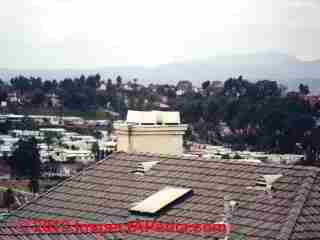
Common causes of factory-built fireplace and chimney and chimney chase fires are the combination of a metal or factory-built fireplace or fire-box and chimney combined with a decorative chimney top cap or shroud that was installed over the manufacturer's spark arrestor and cap assembly. In photos below you can see the remains of the un-listed chimney top, now on the ground after the building fire.
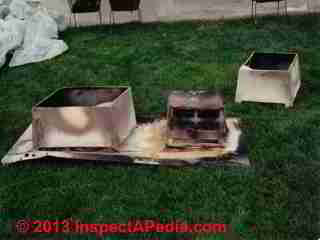
at CHIMNEY SHROUDS we noted reports of chimney & house fires traced to unsafe decorative shrouds installed atop wood chimney chases and factory-built metal chimneys.
Baird (1991) reported on a number of chimney & house fires occurring in California from 1989 through the early 1990's and explained that all of the fires investigated occurred in chimney chases that had been equipped with decorative sheet metal "shrouds".[4]
Below you will note the very extensive roof and ceiling fire damage to the home where this fireplace shroud was installed. At below right the worker is using red paint to mark an unsafe chimney top termination [details needed].
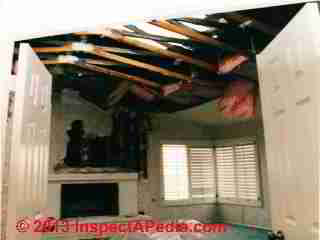
Baird also reported on the reasons that un-listed chimney top shrouds were the cause of serious building fires and recommended a variety of steps to reduce the risk of future fires including using only listed chimney top shrouds and the inspection of both existing and new factory-built fireplace and chimney installations.
Baird concluded that "Failure to fabricate a chase flashing according to the manufacturer's instructions constitutes a violation of the Uniform Mechanical Code" and concluded that "... future installations must not include unlisted attachments to a listed [fireplace or chimney] assembly."[4]
Building Code Citations for Decorative Chimney Top Shrouds
Fake or "counterfeit" UL listing label compared with a valid UL label for chimney top decorative shrouds

Above: counterfeit UL listing label found on the unsafe chimney chase top shroud attributed to cause of the fire described here.
At the request of UL we have overlaid all of these listing labels with a red imprint to make clear that copying of these or any other illustrations at InspectApedia is a violation of federal copyright law as well as other rights and statutes enforced by the listing agency, in this case Underwriters Laboratories.
Below is an example of a valid chimney top shroud UL Listing Label from Chimney King

More examples of listed chimney top shrouds and proper valid UL listing labels for these products can be seen at CHIMNEY SHROUDS.
- International Mechanical Code IMC (2000), M74-98 806.6, ratified 9.98, model building code for the United States,
806.6 Decorative Shrouds. Decorative shrouds shall not be installed at the termination of factory-built chimneys, except where such shrouds are listed and labeled for use with the specific factory-built chimney system and are installed in accordance with section 304.1. Reason: Decorative shrouds have been the cause of roof and chase fires - International Residential Code (IRC) (2000), R1002.2 ratified 9/99, 1000.2 Decorative Shrouds.
Decorative shrouds shall not be installed at the termination of factory-built chimneys, except where such shrouds are listed and labeled for use with the specific factory-built chimney system and are installed in accordance with the manufacturers installation instructions.
Reason: Decorative shrouds often allow for the creation of temperatures in excess of those permitted in UL 103 and UL 127. Decorative shrouds have been the cause of chase top fires ... - International Fire Code (IFC) (2000), IFC 603.6.3, 603.6.3 Decorative Shrouds.
Decorative shrouds installed at the termination of factory-built chimneys shall be removed, except where such shrouds are listed and labeled for use with the specific factory-built chimney system and are installed in accordance with the manufacturers installation instructions.
Reason: Decorative shrouds have been the cause of dozens of chase fires. As a non-listed part to a listed assembly, their use should not have been allowed in the first place. - For Gas Direct Vent appliances, the UL and ANSI standards require any accessory (like a shroud) that is to be used with a direct vent appliance to be tested and listed with the unit.
Contributing to this article:
Chimney fire & UL label photographs were provided by Stephen Werner General Manager Chimney King, LLC P.O. Box 8 Gurnee, IL 60031 Corporate (847) 244-8860 Fax (847) 244-8694 Email: steve@chimneyking.com
- CHIMNEY KING INSTALLATION INSTRUCTIONS FOR CHIMNEY CROWN, [PDF]
- Purdie, Roger K., "CHIMNEY FIRE SAFETY BULLETIN", Vista Fire Protection District, 2001, report of house fire related to the home's metal chimney. Contains advice for chimney * fire safety & sketches of approved and not-code-approved metal chimney tops, caps & crowns. [PDF]
 [2]Stephen Werner, General Manager, Chimney King LLC., P.O. Box 8, Gurnee, IL 60031, Tel: (847) 244-8860, Email: steve@chimneyking.com, Website: www.chimneyking.com . Mr. Werner is also a licensed home inspector serving clients in Wisconsin. Chimney King sells their products through a network of fireplace dealers, chimney sweeps, roofers and builders. Each decorative shroud is custom built because no two chimney chases are alike.
[2]Stephen Werner, General Manager, Chimney King LLC., P.O. Box 8, Gurnee, IL 60031, Tel: (847) 244-8860, Email: steve@chimneyking.com, Website: www.chimneyking.com . Mr. Werner is also a licensed home inspector serving clients in Wisconsin. Chimney King sells their products through a network of fireplace dealers, chimney sweeps, roofers and builders. Each decorative shroud is custom built because no two chimney chases are alike.
InspectAPedia.com is an independent publisher of building, environmental, and forensic inspection, diagnosis, and repair information provided free to the public - we have no business nor financial connection with any manufacturer or service provider discussed at our website.
...
Continue reading at CHIMNEY SHROUD FIRE or select a topic from the closely-related articles below, or see the complete ARTICLE INDEX.
Or see these
Recommended Articles
- CHIMNEY CHASE - Wood framed chimney chases: tips for inspecting wood-framed chimney surrounds and chases
- CHIMNEY CODES
- CHIMNEY FIRE REPORT & chimney fire safety advice: Vista Fire Department, [PDF]
- CHIMNEY INSPECTION DIAGNOSIS REPAIR - home
- CHIMNEY RAIN CAP VENT OPENING SIZE
- CHIMNEY POTS & DECORATIVE TOPS
- CHIMNEY SHROUDS
- CHIMNEY SHROUD FIRE
- CHIMNEY STAINS & LEAKS
Suggested citation for this web page
CHIMNEY CHASE FIRE at InspectApedia.com - online encyclopedia of building & environmental inspection, testing, diagnosis, repair, & problem prevention advice.
Or see this
INDEX to RELATED ARTICLES: ARTICLE INDEX to CHIMNEYS & FLUES
Or use the SEARCH BOX found below to Ask a Question or Search InspectApedia
Ask a Question or Search InspectApedia
Try the search box just below, or if you prefer, post a question or comment in the Comments box below and we will respond promptly.
Search the InspectApedia website
Note: appearance of your Comment below may be delayed: if your comment contains an image, photograph, web link, or text that looks to the software as if it might be a web link, your posting will appear after it has been approved by a moderator. Apologies for the delay.
Only one image can be added per comment but you can post as many comments, and therefore images, as you like.
You will not receive a notification when a response to your question has been posted.
Please bookmark this page to make it easy for you to check back for our response.
IF above you see "Comment Form is loading comments..." then COMMENT BOX - countable.ca / bawkbox.com IS NOT WORKING.
In any case you are welcome to send an email directly to us at InspectApedia.com at editor@inspectApedia.com
We'll reply to you directly. Please help us help you by noting, in your email, the URL of the InspectApedia page where you wanted to comment.
Citations & References
In addition to any citations in the article above, a full list is available on request.
- [1] Stephen Werner General Manager Chimney King, op cit, personal communication 3/26/2013 w/attachments:
- Personal communication & Moorpark CA chimney fire photographs, 4/13/2013
- [3] Wood Heating Alliance, "BUILDING INSPECTOR'S CHECKLIST FOR FACTORY BUILT FIREPLACES [PDF] ", appearing in Baird, David J., C.B.O., "Factory-built Chimney Chase Fires: A case for More Detailed Inspection", Building Standards, March-April 1991, pp. 14-17. Note: The Fireplace Institute (FI) and the Wood Energy Institute (WEI) united to form the Wood Heating Alliance in 1980. The name was then changed again in 1983 to the Hearth Products Association (HPA) a non-profit organization, in order to better reflect the diversity and range of products and services within the industry. The name was changed once more to, Hearth Patio and Barbecue Association (HPBA) in 2001. Pacific HPBA, 2304 Huntington Dr., Suite 218, San Marino, CA 91108
(626) 237-1200 or (888) 332-2472
Fax: (626) 237-0721- info@hpbapacific.org, Website: http://hpbapacific.org/
Fireplace Safety Tips - Barbecue Safety Tips from the HPBA - see http://hpbapacific.org/pdfs/safetytips.pdf - [4] Baird, David J., C.B.O., "Factory-built Chimney Chase Fires: A case for More Detailed Inspection", Building Standards, March-April 1991, pp. 14-17.
- [5] pending
- [6] Residential Masonry Fireplace and Chimney Handbook, James E. Amrhein, S.E., MIA, Masonry Institute of America, 2d. Ed., 1995, ISBN 0-940116-29-4. The MIA is in Los Angeles, CA 213-388-0472. This manual reflects the 1994 Uniform Building Code, Energy Conservation Requirements of California, and the U.S. Department of Housing and Urban Development - HUD. The complete UBC is available from the International Conference of Building Officials (ICBO), Whittier CA 310-699-0541.
- [7] NFPA 211 - Standards for Chimneys & Fireplaces, NFPA 211: Standard for Chimneys, Fireplaces, Vents, and Solid Fuel-Burning Appliances, 2006 Edition (older editions and standards are found at the same bookstore)
- [8] NFPA 211 - Standards for Chimneys & Fireplaces, NFPA 211: Standard for Chimneys, Fireplaces, Vents, and Solid Fuel-Burning Appliances, 2006 Edition (older editions and standards are found at the same bookstore), NFPA #211-3.1 1988 -
Specific to chimneys, fireplaces, vents and solid fuel burning appliances.
- NFPA 211 - 3-1.10 - Relining guide for chimneys
- NFPA 211 - 3-2 - Construction of Masonry Chimneys
- NFPA 211 - 3-3 - Termination Height for chimneys
- NFPA 211 - 3-4 - Clearance from Combustible Material
- NFPA 54 - 7-1 - Venting of Equipment into chimneys
- [9] NFPA # 54-7.1 1992 - Specific to venting of equipment with fan-assisted combustion systems.
- [10] GAMA - Gas Appliance Manufacturers' Association has prepared venting tables for Category I draft hood equipped central furnaces as well as fan-assisted combustion system central furnaces.
- [11] National Fuel Gas Code, an American National Standard, 4th ed. 1988 (newer edition is available) Secretariats, American Gas Association (AGA), 1515 Wilson Blvd., Arlington VA22209, and National Fire Protection Association (NFPA), Batterymarch Park, Quincy MA 02269. ANSI Z223.1-1988 - NFPA 54-1988. WARNING: be sure to check clearances and other safety guidelines in the latest edition of these standards.
- [12] Fire Inspector Guidebook, A Correlation of Fire Safety Requirements Contained in the 1987 BOCA National Codes, (newer edition available), Building Officials and Code Administrators International, Inc. (BOCA), Country Club HIlls, IL 60478 312-799-2300 4th ed. Note: this document is reissued every four years. Be sure to obtain the latest edition.
- [13] Uniform Mechanical Code - UMC 1991, Sec 913 (a.) Masonry Chimneys, refers to Chapters 23, 29, and 37 of the Building Code.
- [14] New York 1984 Uniform Fire Prevention and Building Code, Article 10, Heating, Ventilating, and Air Conditioning Requirements
- New York 1979 Uniform Fire Prevention & Building Code, The "requirement" for 8" of solid masonry OR for use of a flue liner was listed in the One and Two Family Dwelling Code for New York, in 1979, in Chapter 9, Chimneys and Fireplaces, New York 1979 Building and Fire Prevention Code:
- [15] "Top Ten Chimney (and related) Problems Encountered by One Chimney Sweep," Hudson Valley ASHI education seminar, 3 January 2000, contributed by Bob Hansen, ASHI
- [16] Chimney Inspection Checklist, Carson Dunlop, Associates, Toronto, Ontario
- [17] "Rooftop View Turns to Darkness," Martine Costello, Josh Kovner, New Haven Register, 12 May 1992 p. 11: Catherine Murphy was sunning on a building roof when a chimney collapsed; she fell into and was trapped inside the chimney until rescued by emergency workers.
- [18] "Chimneys and Vents," Mark J. Reinmiller, P.E., ASHI Technical Journal, Vol. 1 No. 2 July 1991 p. 34-38.
- [24] Ceramic Roofware, Hans Van Lemmen, Shire Library, 2008, ISBN-13: 978-0747805694
- [25] Chimney Inspection Checklist, Carson Dunlop, Associates, Toronto, Ontario
- [26] Chimney & Stack Inspection Guidelines, American Society of Civil Engineers, 2003 - These guidelines address the inspection of chimneys and stacks. Each guideline assists owners in determining what level of inspection is appropriate to a particular chimney and provides common criteria so that all parties involved have a clear understanding of the scope of the inspection and the end product required. Each chimney or stack is a unique structure, subject to both aggressive operating and natural environments, and degradation over time. Such degradation may be managed via a prudent inspection program followed by maintenance work on any equipment or structure determined to be in need of attention. Sample inspection report specifications, sample field inspection data forms, and an example of a developed plan of a concrete chimney are included in the guidelines. This book provides a valuable guidance tool for chimney and stack inspections and also offers a set of references for these particular inspections.
- [27] Fireplaces, a Practical Design Guide, Jane Gitlin
- [28] Fireplaces, Friend or Foe, Robert D. Mayo
- [29] Principles of Home Inspection: Chimneys & Wood Heating, in (Principles of Home Inspection), Carson Dunlop, Associates, Toronto, Ontario
- [31] Brick Institute of America - Flashing Chimneys
Brick Institute of America - Proper Chimney Crowns
Brick Institute of America - Moisture Resistance of Brick - [32] American Gas Association - New Vent Sizing Tables
- [33] Chimney Safety Institute of America - Chimney Fires: Causes, Effects, Evaluation
- [34] National Chimney Sweep Guild - Yellow Pages of Suppliers
- [35] "Building Codes that Regulate Decorative Chimney Shrouds", provided by Stephen Werner [5], [copy on file as Chimney_Decorative_Shroud_Regs.pdf]
- [36] International Residential Code IRC R100.11 - Fireplace Clearance:
International Residential Code was recently amended:
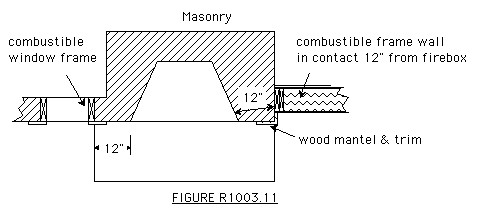 R1001.11 Fireplace clearance. Combustible material shall have a clearance of not less than 2 inches (51 mm) from the front faces and sides of masonry fireplaces and not less than 4 inches (102 mm) from the back faces of masonry fireplaces. The air space shall not be filled, except to provide fire blocking in accordance with Section R1003.12.
R1001.11 Fireplace clearance. Combustible material shall have a clearance of not less than 2 inches (51 mm) from the front faces and sides of masonry fireplaces and not less than 4 inches (102 mm) from the back faces of masonry fireplaces. The air space shall not be filled, except to provide fire blocking in accordance with Section R1003.12.
Exceptions:1. Masonry fireplaces listed and labeled for use in contact with combustibles in accordance with UL 127, and installed in accordance with the manufacturer's installation instructions, are permitted to have combustible material in contact with their exterior surfaces.
2. Combustible materials, including framing, wood siding, flooring and trim, shall be permitted to abut the sides and hearth extensions, but not the backs, of masonry fireplaces, in accordance with FIGURE R1003.12, provided such combustible materials are a minimum of 12 inches (306 mm) from the inside surface of the nearest firebox lining.
3. Exposed combustible mantels or trim may be placed directly on the masonry fireplace front surrounding the fireplace opening provided such combustible materials shall not be placed within 6 inches (153 mm) of a fireplace opening. Combustible material within 12 inches (305 mm) of the fireplace opening shall not project more than 1/8 inch (3.2 mm) for each 1-inch (25 mm) distance from such openings
- [37] International Association of Fireplace and Chimney Inspectors, Inc., IAFCI, 5325 N Commerce Ave Ste 5 Moorpark, CA 93021, Website: http://www.membersiafci.org/ Quoting from the association's website:
The International Association of Fireplace & Chimney Inspectors (IAFCI) is a Non-Profit Association formed to facilitate education and promote professionalism within the Hearth, Fireplace, Vent and Chimney Inspection Industry. ... IAFCI, its Members, and Educational Providers will conform, utilize and assist in the application of recognized standards, listings, and codes for all hearth products intended for service, repair, replacement, or new construction. - In addition to citations & references found in this article, see the research citations given at the end of the related articles found at our suggested
CONTINUE READING or RECOMMENDED ARTICLES.
- Carson, Dunlop & Associates Ltd., 120 Carlton Street Suite 407, Toronto ON M5A 4K2. Tel: (416) 964-9415 1-800-268-7070 Email: info@carsondunlop.com. Alan Carson is a past president of ASHI, the American Society of Home Inspectors.
Thanks to Alan Carson and Bob Dunlop, for permission for InspectAPedia to use text excerpts from The HOME REFERENCE BOOK - the Encyclopedia of Homes and to use illustrations from The ILLUSTRATED HOME .
Carson Dunlop Associates provides extensive home inspection education and report writing material. In gratitude we provide links to tsome Carson Dunlop Associates products and services.


